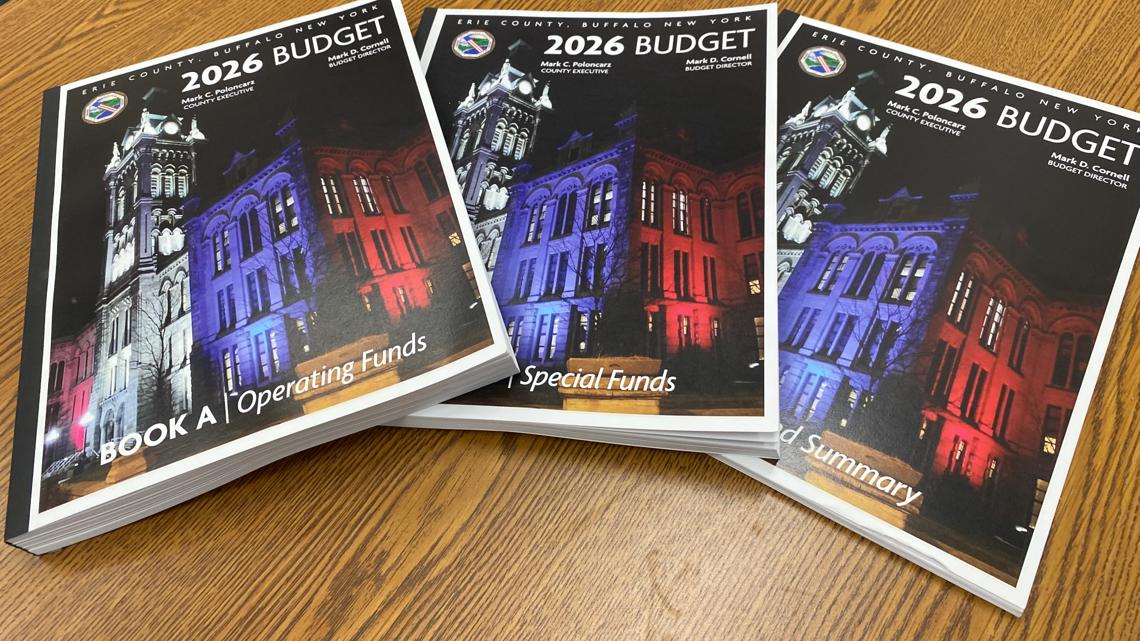For the first time general fund spending would eclipse $2 billon and increase tax levy by $4 million
BUFFALO, N.Y. — Erie County Executive Mark Poloncarz on Wednesday revealed his proposed budget for the coming year.
It sets record highs for both spending and the amount of property taxes the county will take in.
Under the proposal, which now goes to the Erie County legislature for approval, spending would increase by $113 million (roughly 5.75%) next year and the county’s general fund spending would eclipse $2 billion for the first time in history.
The county property tax levy would also increase as part of the spending plan.
Like several county leaders across New York State Poloncarz claims the increased spending, for the most part, is out of his hands
“71% of the $113 million spending increase is coming from mandates from New York State,” Poloncarz said.
However, republican County Legislator Lindsay Lorigo noted the budget calls for the addition of several employees to the county pay roll.
“The county executive continues to add jobs to the budget,” said Lorigo, who represents the 10th Legislative District. “He also continues to grow the county with his $6 million project up in Amherst, the golf course, where he’s going to add staff.”
The budget adds jobs to the county work force and includes additional funding of nearly $1 million for public libraries.
Poloncarz said he also had to say “no” to cultural agencies and not for profits, who were asking for big increases which Poloncarz described as being “beyond the pale”.
“We did not cut the not for profits and culturals, but there was a ridiculous amounts of requests above and beyond what they normally ask for,” said Poloncarz. “We had a number of them coming in saying we are losing federal funding and people are giving less and would the county will make us whole? The answer is no.”
Poloncarz warned of dire fiscal times ahead if the Trump administration succeeds in cutting federal spending, in part by shifting some of the costs of programs traditionally paid for by Washington down to states and perhaps consequently, counties.
He predicted that, if all provisions enacted in The One Big Beautiful Bill stand, the County could be facing funding gaps of $90-100 million within a few years.
“He’s blaming a lot of this on the federal government but I would also remind him in 2024 when the governor (Kathy Hochul, a democrat) passed more costs down to the county government he did not have the same political uproar about that,” Lorigo said.
Poloncarz said it would be possible for Albany to take certain steps to protect counties.
“We can reduce mandated services to the minimum legal level, but that has to come from New York State,” said Poloncarz.
However, when asked by 2 on Your Side if there would be an appetite in the democrat controlled state legislature to do that, or to at least bring spending on social welfare programs in line with what other states spend, Poloncarz replied, “If you asked me what their preference is, I think their preference is to actually increase spending on those programs. But I’m at least glad to know they are not sticking their heads in the sand after what we saw in the most recently approved state budget in which they did allow the governor to make modifications mid-year which they never had before. So, we’ll just have to wait and see.”
Poloncarz was quick to note that he’s proposed another decrease in the county’s property tax rate, which is the amount property owners pay per thousand dollars of assessed value of their properties as determined by their town or village.
But with property values increasing Lorigo says that’s no big accomplishment and that Poloncarz really had no choice.
“If Mark Poloncarz did not reduce the tax rate he would be exceeding the tax cap based on assessments,” said Lorigo. “So this is not the county lowering the taxes. This is the county chasing a headline claiming you will feel some relief in your tax bill and the reality is you are not.”
Indeed, despite the proposed drop in the tax rate the county’s property tax levy – which is the total amount of taxes collected – is still proposed to increase by more than $4 million.

